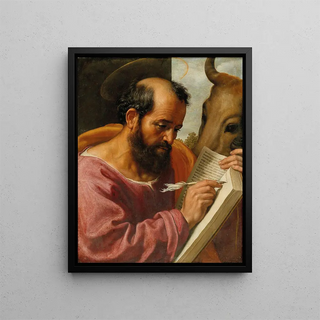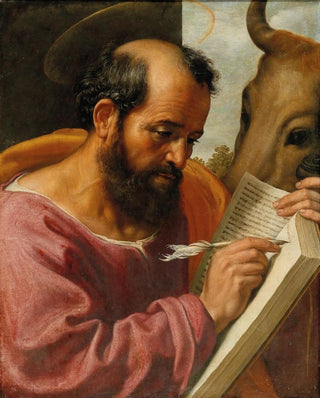Painting Saint Luke the Evangelist - School of Jacob Jordaens | Art print


View from behind

Frame (optional)
Saint Luke the Evangelist - School of Jacob Jordaens – Captivating Introduction
In the vast panorama of art history, certain works stand out for their ability to capture the essence of humanity. "Saint Luke the Evangelist" by the School of Jacob Jordaens is a striking example. This painting, imbued with spirituality and depth, transports us to a world where faith and art intersect. Through the intense gaze of Saint Luke, the artist manages to establish a silent dialogue with the viewer, inviting each person to a personal reflection on faith and creation. The art print of this iconic work allows for rediscovering the richness of this masterpiece, while paying tribute to an artist whose impact on Baroque art is undeniable.
Style and uniqueness of the work
Jordaens' style is characterized by a lively and expressive approach, blending realism and idealization. In "Saint Luke the Evangelist," the palette of warm, earthy colors creates an atmosphere that is both intimate and solemn. The sumptuous draperies that envelop the saint, as well as the meticulous details of his face, demonstrate impressive technical mastery. Light plays a fundamental role in the composition, highlighting the features of the character while creating a striking contrast with the background. This work does not merely depict a sacred moment; it also evokes the passion for art and the vocation of the evangelist, thus emphasizing the link between faith and the act of creating. The dynamic between the subject and the viewer is palpable, making this work particularly immersive and touching.
The artist and his influence
Jacob Jordaens, a major figure of Flemish Baroque, knew how to establish himself through his unique vision of art. Raised in a context where religious painting was predominant, he nevertheless managed to diverge from conventions to explore more universal and profane themes. His work is distinguished by a humanist approach, where the characters are not only sacred figures but human beings endowed with emotions and complexity. Jordaens was also influenced by his contemporaries, such as Rubens, but developed a style that is uniquely his own, blending grandeur

Matte finish

View from behind

Frame (optional)
Saint Luke the Evangelist - School of Jacob Jordaens – Captivating Introduction
In the vast panorama of art history, certain works stand out for their ability to capture the essence of humanity. "Saint Luke the Evangelist" by the School of Jacob Jordaens is a striking example. This painting, imbued with spirituality and depth, transports us to a world where faith and art intersect. Through the intense gaze of Saint Luke, the artist manages to establish a silent dialogue with the viewer, inviting each person to a personal reflection on faith and creation. The art print of this iconic work allows for rediscovering the richness of this masterpiece, while paying tribute to an artist whose impact on Baroque art is undeniable.
Style and uniqueness of the work
Jordaens' style is characterized by a lively and expressive approach, blending realism and idealization. In "Saint Luke the Evangelist," the palette of warm, earthy colors creates an atmosphere that is both intimate and solemn. The sumptuous draperies that envelop the saint, as well as the meticulous details of his face, demonstrate impressive technical mastery. Light plays a fundamental role in the composition, highlighting the features of the character while creating a striking contrast with the background. This work does not merely depict a sacred moment; it also evokes the passion for art and the vocation of the evangelist, thus emphasizing the link between faith and the act of creating. The dynamic between the subject and the viewer is palpable, making this work particularly immersive and touching.
The artist and his influence
Jacob Jordaens, a major figure of Flemish Baroque, knew how to establish himself through his unique vision of art. Raised in a context where religious painting was predominant, he nevertheless managed to diverge from conventions to explore more universal and profane themes. His work is distinguished by a humanist approach, where the characters are not only sacred figures but human beings endowed with emotions and complexity. Jordaens was also influenced by his contemporaries, such as Rubens, but developed a style that is uniquely his own, blending grandeur
12,34 €






